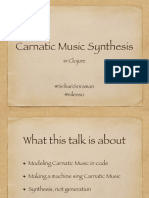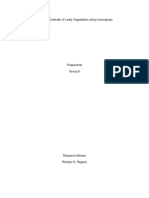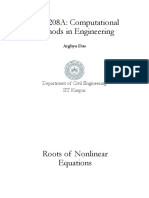Carbonyl Compounds
Uploaded by
sudheerpabbati999Carbonyl Compounds
Uploaded by
sudheerpabbati999
® 1
5. Which one of the following reactions will not
CARBONYL COMPOUNDS form acetaldehyde?
1. Which of the following reagent is used for the (1) CH3CH2OH Cu
573K
following reaction ? (2) CH3CN
(i) DIBAL H
(ii) H O
CH3CH2CH3
?
CH3CH2 CHO
2
(3) CH2=CH2 + O2
Pd(II)/Cu (II)
(1) Manganese acetate
H 2O
CrO H SO
(2) Copper at high temperature and pressure (4) CH3CH2OH 3
2 4
(3) Molybdenum oxide 6. The major product of the following chemical
reaction is :
(4) Potassium permanganate
(1) H3O+,
2. Identify products A and B : (2) SOCl2
CH3 CH3CH2CN ?
(3) Pd/BaSO4,H2
dil. KMnO4 CrO3
273 K
A B (1) CH3CH2CH3 (2) CH3CH2CH2OH
CH3 CH3 (3) (CH3CH2CO)2O (4) CH3CH2CHO
(1) A : OH B: A Hydrolysis B
OH O 7. 373K (C4H8O)
(C4H8Cl2)
CH3 CH3 B reacts with Hydroxyl amine but does not give
(2) A : OH B: OH Tollen's test. Identify A and B
OH O (1) 1,1-Dichlorobutane and 2-Butanone
O (2) 2,2-Dichlorobutane and Butanal
(3) 1,1-Dichlorobutane and Butanal
(3) A : OHC—CH2CH2CH2—C—CH3 (4) 2,2-Dichlorobutane and Butan-2-one
O 8. 2,4-DNP test can be used to identify :
(1) Amine (2) Aldehyde
B : HOOC—CH2CH2CH2—C—CH3 (3) Ether (4) Halogens
CH3 CH3 9. Identify A in the given chemical reaction,
(4) A : B: CH2CH2CHO
OH O
NaOH
C2H5OH, H2O
A(Major product)
CH2CH2CHO
3. Which one of the following carbonyl
CHO
compounds cannot be prepared by addition of (1)
water on an alkyne in the presence of HgSO4
CH2CH2COOH
and H2SO4 ? (2)
O O CH2CH2CH2OH
(1) CH3–C–H (2) C–CH3 O
O O C–H
(3) CH3–CH2–C–H (4) CH3–C–CH2CH3 (3)
O
4. ?
(4)
O O
Which of the following reagent is suitable for
the preparation of the product in the above
reaction ?
(1) NaBH4
(2) NH2–NH2/ C2 H5 ONa
(3) Ni/H2
(4) Red P + Cl2
E
2 ®
10. Identify A in the following chemical reaction O O
Ethylene Glycol
CHO 13. A
OC2H5 H+ (Major Product)
A
(i) HCHO, NaOH
(ii) CH3CH2Br, NaH, DMF
CH3O (iii) HI,
O
The product "A" in the above reaction is:
C – OCH2CH3 OH
O O
(1) (1) OH
HO
CH2OH OC2H5
(2)
CH3O (2) O
CH2I O O
(3)
HO OC2H5
CH2OH
O
(4)
HO OC2H5
(3)
11.
(1) Zn / HCl
(2) Cr2O3 , 773K
1020 atm
OH
O
considering the above reaction, the major (4) O
O O
product among the following is :
CH2CH3 CH2CH2CH3 OH
O
(1) (2)
H , Heat
14. 2
dil.NaOH
"X" "Y"
CH3 COCH2CH3
CH3 Consider the above reaction, the product 'X' and
(3) (4)
'Y' respectively are :
OH
O
(1) Zn / HCl
(2) Cr2 O3 ,773K (1) ,
O 10 20 atm
O O
O
O O
i) DIBAL-H, Toluene, –78°C
12. +
"P" (2) ,
ii) H3O (Major Product)
OH
The product "P" in the above reaction is : O O
OH
(3) ,
COOH OH
(1) (2) CHO
O O
O
(4) ,
O–C–H OH
(3) (4) CHO O
dil.NaOH
"X"
H , Heat
"Y"
2
E
® 3
15. In Tollen's test for aldehyde, the overall number O
of electron(s) transferred to the Tollen's reagent
formula [Ag(NH3)2]+ per aldehyde group to CH3CHO (i) I2/NaOH, Filter
19. 'P' 'X'
NaOH (ii) Filtrate + HCl
form silver mirror is_______.(Round off to the (Major
Nearest integer) product)
OH Consider the given reaction, the product 'X' is:
O OH O O
16. CHO O
OH (1) (2)
OH
(I) (II) (III) (IV)
Which among the above compound/s does/do
OH O O
not form Silver mirror when treated with
Tollen's reagent? (3) (4)
(1) (I), (III) and (IV) only CHO OH
(2) Only (IV)
(3) Only (II) 20. An organic compound 'A' C4H8 on treatment
(4) (III) and (IV) only
17. The major product (P) in the following reaction with KMnO4/H+ yields compound 'B' C3H6O.
is : Compound 'A' also yields compound 'B' an
O ozonolysis. Compound 'A' is :
CHO
(i) KOH (alc.)
P (1) 2–Methylpropene
(ii) H+,
(major product) (2) 1–Methylcyclopropane
O
O
(3) But–2–ene
OHC O
(4) Cyclobutane
(1) (2) 21. A reaction of benzonitrile with one equivalent
O CH3MgBr followed by hydrolysis produces a
O yellow liquid "P". The compound "P" will give
CHO positive_____.
(3) (4) (1) Iodoform test (2) Schiff's test
t – +
O O 22. Br EtOH excess
CHO
dry HCl gas
BuO K
"A" "B"
(major (major
O
(i) C2H5MgBr, dry ether product) product)
18. (ii) H2O, HCl
P [where Et –C2H5 tBu (CH3)3C–]
(Major product) Consider the above reaction sequence, Product
Consider the above reaction, the major product "A" and Product "B" formed respectively are :
'P' is: OEt H2C OEt
OH (1) Br
(1) ,
OEt OEt
OH OtBu
(2) EtO CHO EtO
(2) ,
OH
OH OEt H2C OEt
(3) EtO
(3) ,
OEt OEt
Cl
OEt OEt
OH (4) Br t
BuO
(4) ,
Cl OEt OEt
E
4 ®
23. Which one of the following compounds will 26. Match List-I with List-II :
give orange precipitate when treated with
2,4-dinitrophenyl hydrazine ? List-I List-II
OH (Chemical Reaction) (Reagent used)
(1)
OCH2CH3 (a) CH3COOCH2CH3CH3CH2OH (i) CH3MgBr / H3O+
(1.equivalent)
O (b) CH3COOCH3 CH3CHO (ii) H2SO4 / H2O
O
(c) CH3C N CH3CHO (iii) DIBAL-H/H2O
(2) OCH2CH3 O
(d) CH3C N CH3 CH3 (iv) SnCl2, HCl/H2O
O Choose the most appropriate match :
C– OH
(1) a-ii, b-iv, c-iii, d-i
(3)
(2) a-iv, b-ii, c-iii, d-i
OH
O (3) a-ii, b-iii, c-iv, d-i
(4) CH3 (4) a-iii, b-ii, c-i, d-iv
(i) DIBAL H O OH
24. R – CN R–Y
(ii) H O 2 "X" CN
Consider the above reaction and identify "Y" H HCN,H O H
2
(1) –CH2NH2 (2) –CONH2 27.
(3) –CHO (4) –COOH "Y" LiAlH4
(i) DIBAL H +
R – CN (ii) H O
R–Y (Major Product) H3O
2
25. The major products formed in the following Consider the given reaction, Identify 'X' and
reaction sequence A and B are :
O
'Y' :
CH3 Br2 OH
A+B
KOH NH2
(1) X – NaOH Y – H
O
(1) A = C , B=CHBr3 OH
OK
(2) (2) X – HNO3 Y –
H NH2
O O
A= C–CH2–Br ,B= C–CH2–OH OH
Br Br (3) X – NaOH Y –
H NH2
O
(3) A= OH
C–CBr3 , B= CHO
NH2
(4) X – HNO3 Y – H
Br O HO O
(4) A= C–CH3 , B= C–CH3
Br HO
E
® 5
28. A chloro compound "A". (4) diol
(i) forms aldehydes on ozonolysis followed by 32. In the following sequence of reactions,
the hydrolysis. C3H6
H /H O
A
2
KIO
B + C
dil KOH
(ii) when vaporized completely 1.53 g of A,
The compounds B and C respectively are :
gives 448 mL of vapour at STP.
(1) CI3COOK, HCOOH (2) CI3COOK, CH3I
The number of carbon atoms in a molecule of
(3) CH3I, HCOOK (4) CHI3, CH3COOK
compound A is _______.
33. Given below are two statements :
29. In the following sequence of reactions, the final
Statement I : The nucleophilic addition of sodium
product D is :
hydrogen sulphite to an aldehyde or a ketone
OH
Br CH3
involves proton transfer to form a stable ion.
H2/Pd–C
CH3–CC–H+NaNH2 A B C CrO3 D
Statement II : The nucleophilic addition of
O
hydrogen cyanide to an aldehyde or a ketone
(1) H3C–CH2–CH2–CH2–CH2–C–H
yields amine as final product.
(2) CH3–CH=CH–CH2–CH2–CH2–COOH In the light of the above statements, choose the
(3) H3C–CH=CH–CH(OH)–CH2–CH2–CH3 most appropriate answer from the options
O given below :
(4) CH3–CH2–CH2–CH2–CH2–C–CH3
(1) Both Statement I and Statement II are true.
30. The structure of the starting compound P used (2) Statement I is true but Statement II is false.
in the reaction given below is : (3) Statement I is false but Statement II is true.
OH (4) Both Statement I and Statement II are false.
1. NaOCl
P
2. H3O+
O
H
(1) (2)
O O
O
O
(3) (4)
31. For the reaction given below :
CHO
1. NaOH,
Product
2. H3O+
CH2OH
The compound which is not formed as a
product in the reaction is a :
(1) compound with both alcohol and acid
functional groups
(2) monocarboxylic acid
(3) dicarboxylic acid
E
6 ®
SOLUTION 5. Official Ans. by NTA (4)
1. Official Ans. by NTA (3) O
CrO3H2SO4
Sol. CH3–CH2–OH CH3–C–OH
Sol. CH3–CH2–CH3
MO O
CH3–CH2–CH=O
2 3 Strong oxidising
agent (Carboxylic
acid is formed
The reagent used will be MO2O3 by complete
oxidation )
2. Official Ans. by NTA (2)
HO 6. Official Ans. by NTA (4)
dil.KMnO4 O O
Sol. 273 K
(i) H3O /
+
(2) SOCl
(A) Sol. Et-CN Et–C–OH Et–C–Cl
2
OH O (3) Pd/BaSO 4
H2
CrO3 Et–C–H Resonmund's
reduction
O
Final product of reaction is propanaldehyde.
7. Official Ans. by NTA (4)
OH
Sol.
3. Official Ans. by NTA (3)
Cl OH O
Sol. Reaction of HgSO4/dil.H2SO4 with alkyne gives Hydrolysis
373 K –H2O
addition of water as per markonikoff's rule. Cl OH
O (C4H8Cl2) (C4H8O)
HgSO
(1) HCCH H SO 4 CH2–CH CH3–CH (A) (B)
2 4
OH
8. Official Ans. by NTA (2)
HgSO
(2) CCH H SO 4 Sol. 2,4-DNP test is useful for the identification of
2 4
O carbonyl compounds.
C=CH2 C–CH3
9. Official Ans. by NTA (3)
OH
O Sol.
HgSO4
(3) CH3–CCH H SO CH3–C=CH2 CH3–C–CH3 O
2 4
OH CH2 CH C H
Hence CH3–CH2–CHO cannot be form. H OH—
HgSO CH2 CH2 C H
(4) CH3–CC–CH3 H SO 4 CH3–C=CH–CH3 O
2 4
OH O 2
CHO 3 1
H
H
CH3–C–CH2–CH3 7 H
OH 4 6
O 5
O
4. Official Ans. by NTA (2)
CHO
C2H5OH/
(i) NH2–NH2 –H2O
Sol. (ii) EtO– Na+/
O
To reduce the carbonyl groups into alkane wolf
– kischner reduction is used, without affecting
the double bond.
E
® 7
10. Official Ans. by NTA (3) 14. Official Ans. by NTA (3)
O O O
Sol.
Sol. H OH
O –H2O
C–H
NaOH H2O
+ H–C–H Cannizaro
H – C – ONa
O O
OCH3 O OH
+ O
H3CO CH2 – OH
(X)
(Y)
15. Official Ans. by NTA (2)
CH3–CH2–Br
Sol. AgNO3 + NaOH AgOH + NaNO3
H3C – O CH2 – O – CH2 – CH3 2AgOH Ag2O + H2O
I–H I–H
Ag2O + 4NH3 + H2O 2Ag(NH3)2+ + 2OH
.
HI O .
– HO O
–e + OH
R–C–H
CH2 – I + R H R H
O Ag Ag
+ CH3 – I + CH3 – CH2 – OH
HI
OH O OH
e–
CH3–CH2–I . HO .
Ag Ag
+
R OH R OH
11. Official Ans. by NTA (1)
Sol. Zn – Hg / HCl R – C – OH R–C–O
O O
O Cr2O3, 773 K –
10–20 atm Total 2e transfer to Tollen's reagent
16. Official Ans. by NTA (3)
Sol. Aldehydes give ve Tollen's Test (Silver mirror
test)
Tollen's test
12. Official Ans. by NTA (2) (I) Positive
CHO
O H
O OH O
OH C=O Tauto
(i) DIBAL-H (II) Negative
Sol. (ii) H3O Ketone
O
DIBAL can not reduce double bond (III) Tauto Positive
OH H
It can reduce cyclic ester.
13. Official Ans. by NTA (2) O [Ag(NH3)2]+OH O O
(IV) H
–H2O
OH OH O
O O O
OH O OO Hemiacetal
Sol. +
C2H5
OC2H5 H O
Positive
E
8 ®
17. Official Ans. by NTA (2) 20. Official Ans. by NTA (1)
H3C CH3
Sol. CH=O C=O KMnO4/H H3C
CH2–CH2 (i) KOH (alc.) O O
O (ii)H+. Sol.H3C CH2 Ozonolysis
O H3C
Intramolecular Aldol condenstion (P)
2-Methylpropene C3H6O
(Major Product)
18 Official Ans. by NTA (3) 21. Official Ans. by NTA (1)
Sol. Sol.
O O Mg
CH3–CH2MgBr CH3
1,2-Addition CN C = NMgBr
CH3MgBr
Benzonitrile H3O+
HHOH | HCl
O–H OH C – CH3 + NH3
O
It gives positive Iodoform test
Cl–
22. Official Ans. by NTA (1)
OH Sol.
EtOH (excess)
Br – CH2 – CH = O
Dry HCl gas
Cl
OEt
19. Official Ans. by NTA (4) Br – CH2 – CH (Acetal)
(A)
Sol. OEt
E2 Tertiary
mechanism butoxide
OEt
O O CH2 = C
O CH3–C–H O O (B)
OH OEt
H CH
CH3
Enolate RDS
23. Official Ans. by NTA (4)
O
H–O–H
C
O
O O OH Sol. CH3
C–ONa (i) I2, NaOH
+ CHI3 CH3
(Yellow ppt) Iodoform Test Explanation 2-4-D.N.P test is used for
(Filtrate)
carbonyl compound (aldehyde & ketone)
HCl
24. Official Ans. by NTA (3)
O O (1) DiBAL–H
Sol. R–CN R–CH
(2) H2O
OH O
Here Y is –C–H Aldehyde
O
E
® 9
25. Official Ans. by NTA (1) 29. Official Ans. by NTA (4)
— +
Sol. C–CH3
Br2 Sol. CH3–CCH + NaNH2 CH3–CC Na + NH3
A+B (A)
+KOH
O OH
O Br CH3
(1) OH
C , B=CHBr3 H
OK CH3–CC–CH2–CH2–CH–CH3
(B)
26. Official Ans. by NTA (3) H2/Pd–C
Sol.
CH3–CH2–CH2–CH2–CH2–CH–CH3
H3O+
CH3–C–O–CH2CH3 CH3CO2H+CH3CH2OH CrO3 (C)
OH
O
CH3–CH2–CH2–CH2–CH2–C–CH3 (D)
CH3–C–O–CH3 DIBALH/H2O CH3CHO O
–78ºC
O
30. Official Ans. by NTA (1)
SnCl2+HCl CH CH=O Sol.
CH3–CN 3
/H2O
O O
O NaOCl
CH3MgBr (1eq) H3O+ OH + CHCl3
CH3–CN
/H3O+ [P]
chloroform
Methyl ketone
27. Official Ans. by NTA (3)
NaOCl is used in haloform reaction as reagent.
Sol.
31. Official Ans. by NTA (3)
O OH
NaOH(x) Sol.
H HCN/H2O H CN CHO CH2–OH COO–Na+
X NaOH
LiAlH4 NaOH
+
OH OH
NH2 NH2
Y
H H CH2–OH CH2–OH CH2–OH
(major product)
28. Official Ans. by NTA (3) H3O+
Sol. 448 ml of A 1.53 gm A
CH2–OH COOH
1.53
22400 ml of A × 22400 gm A = 7650
445
+
H3CHC–CH–Cl O3
CH3–CH=O
It has 3 carbon atoms Zn /H2O Aldehyde
CH2OH CH2–OH
& mm is 36 + 5 + 35.5 = 76.5
E
10 ®
32. Official Ans. by NTA (4)
Sol.
O
H/H2O
CH3 CH CH2 CH3 CH CH3
(C3H6) (A)
(Iodoform) KOI/dil·KOH
CHI3 + CH3 C OK
O
(B) (C)
33. Official Ans. by NTA (2)
Sol. Statement I : Correct
NaHSO3 O
C O C O
S O H transfer
O of proton
OH
C
SO3Na
(White crystalline
soluble ppt)
Statement II :
HC OH
C O C
CN
HCN [Cyanohydrin]
amin Wrong statement
(Amine not formed)
You might also like
- Product Team Cialis - Getting Ready To Market - Case SolutionNo ratings yetProduct Team Cialis - Getting Ready To Market - Case Solution6 pages
- Class 12 Book 5 Organic Chemistry Carbonyl CompoundNo ratings yetClass 12 Book 5 Organic Chemistry Carbonyl Compound28 pages
- Chemistry Assignments (14-10-2024 To 19-10-2024)No ratings yetChemistry Assignments (14-10-2024 To 19-10-2024)11 pages
- Online Neet Objective Examination Chemistry: 10 - 09 - 2020 21K/TP/NEET/ BATCH: All ResidentialNo ratings yetOnline Neet Objective Examination Chemistry: 10 - 09 - 2020 21K/TP/NEET/ BATCH: All Residential22 pages
- Aldehydes, Ketones and Carboxylic Acids - DPPsNo ratings yetAldehydes, Ketones and Carboxylic Acids - DPPs19 pages
- Aldehydes , Ketones Carboxylic Acid and Acid Derivatives _ SBM __ Lakshya JEE AIR O1 (2026)No ratings yetAldehydes , Ketones Carboxylic Acid and Acid Derivatives _ SBM __ Lakshya JEE AIR O1 (2026)11 pages
- 004 Aldehyde, Ketone & Carboxylic Acid DPP 01 Varun JEE AdvancNo ratings yet004 Aldehyde, Ketone & Carboxylic Acid DPP 01 Varun JEE Advanc7 pages
- Aldehdyes and Ketones - JEE Mains PYQ 2020-2022 (1_240627_191755No ratings yetAldehdyes and Ketones - JEE Mains PYQ 2020-2022 (1_240627_19175538 pages
- Aldehdyes and Ketones - JEE Mains PYQ 2020-2022No ratings yetAldehdyes and Ketones - JEE Mains PYQ 2020-2022194 pages
- Aldehydes , Ketones and Carboxylic Acid _ Class Notes __ Manzil JEE 2025No ratings yetAldehydes , Ketones and Carboxylic Acid _ Class Notes __ Manzil JEE 2025111 pages
- MahaYudhDPP1 Aldehyde Ketone CarboxylicAcidNo ratings yetMahaYudhDPP1 Aldehyde Ketone CarboxylicAcid13 pages
- 14) Carbonyl Compounds and Carboxylic AcidsNo ratings yet14) Carbonyl Compounds and Carboxylic Acids11 pages
- Ch-18_Aldehydes_Ketones_and_Carboxylic_Acids_Arjuna_JEE_AIR_2.0_202667665a7d5997c2d2ebadc8d3No ratings yetCh-18_Aldehydes_Ketones_and_Carboxylic_Acids_Arjuna_JEE_AIR_2.0_202667665a7d5997c2d2ebadc8d316 pages
- ALDEHYDES, KETONES, ACIDS-01-170419: Neet-Crash-2017 Chemistry TestNo ratings yetALDEHYDES, KETONES, ACIDS-01-170419: Neet-Crash-2017 Chemistry Test6 pages
- C - Ch-26 - Aldehydes Ketones and Carboxylic AcidsNo ratings yetC - Ch-26 - Aldehydes Ketones and Carboxylic Acids10 pages
- Iit Questions On Carbonyl Compounds & Carboxylic Acid and Its DerivativeNo ratings yetIit Questions On Carbonyl Compounds & Carboxylic Acid and Its Derivative12 pages
- Aldehydes , Ketones and Carboxylic Acid _ Class Notes __ Manzil JEE 2025_removedNo ratings yetAldehydes , Ketones and Carboxylic Acid _ Class Notes __ Manzil JEE 2025_removed50 pages
- 12A2 Quiz On Carbony Compounds Basic LevelNo ratings yet12A2 Quiz On Carbony Compounds Basic Level10 pages
- +2 NEET IntelliQuest PCB-3 (28.01.2021) - 10645294No ratings yet+2 NEET IntelliQuest PCB-3 (28.01.2021) - 1064529422 pages
- Carbonyl Compounds (Aldehydes - Ketones) - Carboxylic Acids ExercisesNo ratings yetCarbonyl Compounds (Aldehydes - Ketones) - Carboxylic Acids Exercises38 pages
- Carbonyl Compounds (Aldehydes - Ketones) - Carboxylic Acids APSPNo ratings yetCarbonyl Compounds (Aldehydes - Ketones) - Carboxylic Acids APSP34 pages
- Acidicity Basicity & H - Bonding TautomerismNo ratings yetAcidicity Basicity & H - Bonding Tautomerism10 pages
- Aldehyde, Ketones & Carboxylic Acids Amines BiomoleculesNo ratings yetAldehyde, Ketones & Carboxylic Acids Amines Biomolecules45 pages
- 18_Revision Assignment_Aldihyde, Ketone & Carboxylic-Acid_02-12-2024_SCNo ratings yet18_Revision Assignment_Aldihyde, Ketone & Carboxylic-Acid_02-12-2024_SC7 pages
- Balancing Chemical Equations: Things You Should Know (Questions and Answers)From EverandBalancing Chemical Equations: Things You Should Know (Questions and Answers)No ratings yet
- (Ebook) Not Quite Shamans: Spirit Worlds and Political Lives in Northern Mongolia by Morten Axel Pedersen ISBN 9780801449109, 0801449103 downloadNo ratings yet(Ebook) Not Quite Shamans: Spirit Worlds and Political Lives in Northern Mongolia by Morten Axel Pedersen ISBN 9780801449109, 0801449103 download52 pages
- Verse 1:: John Legend Keyofc WWW - Flutenotes.PhNo ratings yetVerse 1:: John Legend Keyofc WWW - Flutenotes.Ph15 pages
- J. Jarvis Trial Balance As at 31 December 2010100% (1)J. Jarvis Trial Balance As at 31 December 20103 pages
- Netpeople and Horus Finance Run Together A Fast Driven Sap ImplementationNo ratings yetNetpeople and Horus Finance Run Together A Fast Driven Sap Implementation2 pages
- Official United States Visits by Pakistani Leaders (Complete List)No ratings yetOfficial United States Visits by Pakistani Leaders (Complete List)2 pages
- My Husband Is A Mafia Boss Season 3 Yana WattpadtxtNo ratings yetMy Husband Is A Mafia Boss Season 3 Yana Wattpadtxt59 pages
- Cambridge ESOL CELTA Course Full-Time Course Timetable Course Number: C1/2008 Centre Number: 11256100% (1)Cambridge ESOL CELTA Course Full-Time Course Timetable Course Number: C1/2008 Centre Number: 112563 pages
- ESO 208A: Computational Methods in Engineering: Department of Civil Engineering IIT KanpurNo ratings yetESO 208A: Computational Methods in Engineering: Department of Civil Engineering IIT Kanpur14 pages

























































































